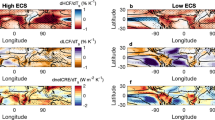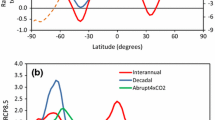Abstract
This study diagnoses the climate sensitivity, radiative forcing and climate feedback estimates from eleven general circulation models participating in the Fifth Phase of the Coupled Model Intercomparison Project (CMIP5), and analyzes inter-model differences. This is done by taking into account the fact that the climate response to increased carbon dioxide (CO2) is not necessarily only mediated by surface temperature changes, but can also result from fast land warming and tropospheric adjustments to the CO2 radiative forcing. By considering tropospheric adjustments to CO2 as part of the forcing rather than as feedbacks, and by using the radiative kernels approach, we decompose climate sensitivity estimates in terms of feedbacks and adjustments associated with water vapor, temperature lapse rate, surface albedo and clouds. Cloud adjustment to CO2 is, with one exception, generally positive, and is associated with a reduced strength of the cloud feedback; the multi-model mean cloud feedback is about 33 % weaker. Non-cloud adjustments associated with temperature, water vapor and albedo seem, however, to be better understood as responses to land surface warming. Separating out the tropospheric adjustments does not significantly affect the spread in climate sensitivity estimates, which primarily results from differing climate feedbacks. About 70 % of the spread stems from the cloud feedback, which remains the major source of inter-model spread in climate sensitivity, with a large contribution from the tropics. Differences in tropical cloud feedbacks between low-sensitivity and high-sensitivity models occur over a large range of dynamical regimes, but primarily arise from the regimes associated with a predominance of shallow cumulus and stratocumulus clouds. The combined water vapor plus lapse rate feedback also contributes to the spread of climate sensitivity estimates, with inter-model differences arising primarily from the relative humidity responses throughout the troposphere. Finally, this study points to a substantial role of nonlinearities in the calculation of adjustments and feedbacks for the interpretation of inter-model spread in climate sensitivity estimates. We show that in climate model simulations with large forcing (e.g., 4 × CO2), nonlinearities cannot be assumed minor nor neglected. Having said that, most results presented here are consistent with a number of previous feedback studies, despite the very different nature of the methodologies and all the uncertainties associated with them.














Similar content being viewed by others
Notes
The GFDL model’s kernels are available at http://metofis.rsmas.miami.edu/~bsoden/data/kernels.html.
References
Andrews T, Forster P (2008) CO2 forcing induces semi-direct effects with consequences for climate feedback interpretations. Geophys Res Lett 35:L04,802
Andrews T, Gregory J, Webb M, Taylor K (2012) Forcing, feedbacks and climate sensitivity in CMIP5 coupled atmosphere-ocean climate models. Geophys Res Lett 39(9):L09,712
Arrhenius S (1896) On the influence of carbonic acid in the air upon the temperature of the ground. Lond Edinb Dublin Philos Mag J Sci 41(251):237–276
Block K, Mauritsen T (2013) Forcing and feedback in the MPI-ESM-LR coupled model under abruptly quadrupled CO2. J Adv Model Earth Syst (submitted)
Boer G, Yu B (2003) Climate sensitivity and climate state. Clim Dyn 21(2):167–176
Bony S, Dufresne J (2005) Marine boundary layer clouds at the heart of tropical cloud feedback uncertainties in climate models. Geophys Res Lett 23:L20,806
Bony S, Dufresne JL, Treut HL, Morcrette JJ, Senior C (2004) On dynamic and thermodynamic components of cloud changes. Clim Dyn 22:71–86
Bony S, Colman R, Kattsov V, Allan R, Bretherton C, Dufresne J, Hall A, Hallegatte S, Holland M, Ingram W, et al (2006) How well do we understand and evaluate climate change feedback processes? J Clim 19(15):3445–3482
Bony S, Stevens B, Held I, Mitchell J, Dufresne JL, Emanuel K, Friedlingstein P, Griffies S, Senior C (2013a) Carbon dioxide and climate: perspectives on a scientific assessment. In: Hurrel J, Asran G (eds) Climate science for serving society: research, modelling and prediction priorities. Springer, Monograph
Bony S, Bellon G, Klocke D, Sherwood S, Fermepin S, Denvil S (2013b) Robust direct effect of carbon dioxide on tropical circulation and regional precipitation. Nat Geosci (in press)
Cess R, Potter G, Blanchet J, Boer G, Del Genio A, Deque M, Dymnikov V, Galin V, Gates W, Ghan S, et al (1990) Intercomparison and interpretation of climate feedback processes in 19 atmospheric general circulation models. J Geophys Res 95(16):601,216
Charney JG, et al (1979) Carbon dioxide and climate: a scientific assessment : report of an ad hoc study group on carbon dioxide and climate, woods hole, Massachusetts, July 23–27, 1979 to the climate research board, assembly of mathematical and physical sciences, National Research Council. National Academy of Sciences: available from Climate Research Board, http://books.google.com/books?id=cj0rAAAAYAAJ
Colman R, McAvaney B (2011) On tropospheric adjustment to forcing and climate feedbacks. Clim Dyn 36(9):1649–1658
Denman K, Brasseur G, Chidthaisong A, Ciais P, Cox P, Dickinson R, Hauglustaine D, Heinze C, Holland E, Jacob D, et al (2007) Couplings between changes in the climate system and biogeochemistry. Climate change 2007: the physical science basis contribution of working group I to the fourth assessment report of the intergovernmental panel on climate change [Solomon S, D Qin, M Manning, Z Chen, M Marquis, KB Averyt, MTignor and HL Miller (eds)]
Dufresne JL, Bony S (2008) An assessment of the primary sources of spread of global warming estimates from coupled atmosphere-ocean models. J Clim 21:5135–5144
Forster P, Ramaswamy V, Artaxo P, Berntsen T, Betts R, Fahey D, Haywood J, Lean J, Lowe D, Myhre G, et al (2007) Changes in atmospheric constituents and in radiative forcing. Climate change 2007: the physical science basis contribution of working group I to the fourth assessment report of the intergovernmental panel on climate change [Solomon, S, D Qin, M Manning, Z Chen, M Marquis, KB Averyt, MTignor and HL Miller (eds)]
Gregory J, Webb M (2008) Tropospheric adjustment induces a cloud component in CO2 forcing. J Clim 21:58–71
Gregory JM, Ingram WJ, Palmer MA, Jones GS, Thorpe PASRB, Lowe JA, Johns TC, Williams KD (2004) A new method for diagnosing radiative forcing and climate sensitivity. Geophys Res Lett 31:L03,205
Hansen J, Sato M, Ruedy R, Nazarenko L, Lacis A, Schmidt G, Russell G, Aleinov I, Bauer M, Bauer S, et al (2005) Efficacy of climate forcings. J Geophys Res 110(D18):D18,104
Held I, Soden B (2000) Water vapor feedback and global warming 1. Annu Rev Energy Environ 25(1):441–475
Held IM, Shell KM (2012) Using relative humidity as a state variable in climate feedback analysis. J Clim 25(8):2578–2582
Jonko A, Shell K, Sanderson B, Danabasoglu G (2012) Climate feedbacks in CCSM3 under changing CO2 forcing. Part I: adapting the linear radiative kernel technique to feedback calculations for a broad range of forcings. J Clim 25(15):5260–5272
Knutti R, Hegerl G (2008) The equilibrium sensitivity of the earth’s temperature to radiation changes. Nat Geosci 1(11):735–743
Mauritsen T, Graversen RG, Klocke D, Langen PL, Bjorn S, Tomassini L (2013) Climate feedback efficiency and synergy. Clim Dyn (submitted)
Randall D, Wood R, Bony S, Colman R, Fichefet T, Fyfe J, Kattsov V, Pitman A, Shukla J, Srinivasan J, et al (2007) Climate models and their evaluation. Clim Change 323
Shell KM, Kiehl JT, Shields CA (2008) Using the radiative kernel technique to calculate climate feedbacks in NCAR’s community atmospheric model. J Clim 21:2269–2282
Soden B, Held I (2006) An assessment of climate feedbacks in coupled ocean-atmosphere models. J Clim 19(14):3354–3360
Soden B, Held I, Colman R, Shell K, Kiehl J, Shields C (2008) Quantifying climate feedbacks using radiative kernels. J Clim 21(14):3504–3520
Soden BJ, Broccoli AJ, Hemler RS (2004) On the use of cloud forcing to estimate cloud feedback. J Clim 19:3661–3665
Taylor KE, Stouffer RJ, Meehl GA (2012) An overview of CMIP5 and the experiment design. Bull Am Meteorol Soc 93(4):485–498. doi:10.1175/BAMS-D-11-00094.1
Webb M, Senior C, Sexton D, Ingram W, Williams K, Ringer M, McAvaney B, Colman R, Soden B, Gudgel R, et al (2006) On the contribution of local feedback mechanisms to the range of climate sensitivity in two GCM ensembles. Clim Dyn 27(1):17–38
Wetherald RT, Manabe S (1988) Cloud feedback processes in a general circulation model. J Atmos Sci 45:1397–1415
Zhang M, et al. (2012) CGILS: first results from an international project to understand the physical mechanisms of low cloud feedbacks in general circulation models. Bull Am Meteorol Soc (submitted)
Acknowledgments
The research leading to these results has received funding from the European Union, Seventh Framework Programme (FP7/2007–2013) under Grant agreement no 244067 for the EUCLIPSE project, and under GA 226520 for the COMBINE project. The work was also partially funded by the ANR ClimaConf project. We acknowledge the World Climate Research Programme’s Working Group on Coupled Modelling, which is responsible for CMIP, and we thank the climate modeling groups (listed in Table 1 of this paper) for producing and making available their model output. For CMIP the U.S. Department of Energy’s Program for Climate Model Diagnosis and Intercomparison provides coordinating support and led development of software infrastructure in partnership with the Global Organization for Earth System Science Portals. The authors would like to acknowledge Karen Shell and Brian Soden for making the NCAR and GFDL models’ radiative kernels freely available online at http://people.oregonstate.edu/~shellk/kernel.html. Finally, we thank Christelle Castet for her participation to this study, and we acknowledge the anonymous reviewers for their helpful comments and suggestions.
Author information
Authors and Affiliations
Corresponding author
Rights and permissions
About this article
Cite this article
Vial, J., Dufresne, JL. & Bony, S. On the interpretation of inter-model spread in CMIP5 climate sensitivity estimates. Clim Dyn 41, 3339–3362 (2013). https://doi.org/10.1007/s00382-013-1725-9
Received:
Accepted:
Published:
Issue Date:
DOI: https://doi.org/10.1007/s00382-013-1725-9




